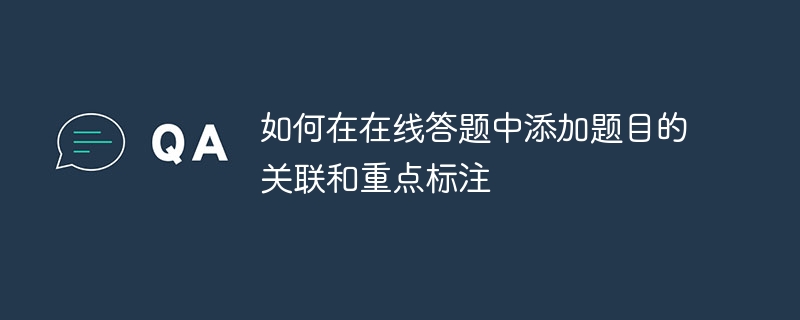

How to add question associations and keynotes in online answering questions
Introduction:
In the online answering system, in order to better solve the learning needs of students , how to add correlation and key annotation of the topic becomes particularly important. By adding associations and key annotations to questions, students can improve their answering efficiency and enhance their understanding of knowledge points. This article will introduce how to achieve correlation and key annotation of questions in online answer questions, and also give specific code examples.
1. Implementation of question correlation
Question correlation refers to connecting related questions so that students can automatically jump to the related questions during the answer process. The following is a code example to implement question association:
// 题目对象
class Question {
String content; // 题目内容
String relatedQuestionId; // 相关联的题目ID
}
// 在答题页面加载时,根据当前题目的ID和相关联的题目ID,设置跳转链接
function loadQuestion(questionId) {
let question = getQuestionById(questionId);
let relatedQuestionId = question.relatedQuestionId;
let relatedQuestionUrl = generateQuestionUrl(relatedQuestionId);
addRelatedLink(relatedQuestionUrl);
}
// 根据题目ID获取题目信息
function getQuestionById(questionId) {
// 通过题目ID查询数据库或调用API获取题目信息
// 省略具体实现
}
// 根据题目ID生成题目链接
function generateQuestionUrl(questionId) {
// 拼接题目链接前缀和题目ID,生成题目链接
// 省略具体实现
}
// 在答题页面中添加相关联题目的链接
function addRelatedLink(relatedQuestionUrl) {
// 将相关联题目的链接添加到答题页面的合适位置
// 省略具体实现
}Through the above code example, we can find the associated question ID based on the current question ID in the answer page and generate a jump link. During the process of answering questions, students can click on the link of the related question to jump to the corresponding question, making it convenient to study and answer the question.
2. Implementation of key labeling of topics
Key labeling of topics refers to highlighting the key content in the title so that students can find the key content in the title more intuitively. The following is a code example to implement key annotation of the question:
// 题目对象
class Question {
String content; // 题目内容
List<String> keyPoints; // 题目重点
}
// 在答题页面加载时,根据题目的重点内容进行标注
function loadQuestion(questionId) {
let question = getQuestionById(questionId);
let keyPoints = question.keyPoints;
markKeyPoints(keyPoints);
}
// 在题目中标注重点内容
function markKeyPoints(keyPoints) {
// 遍历题目中的每个重点内容,使用HTML标签或CSS样式进行标注
// 省略具体实现
}Through the above code example, we can annotate the key content of the question when the answer page is loaded. Through the use of HTML tags or CSS styles, we can mark the key content in the question in bold fonts, highlighted backgrounds, etc. During the process of answering questions, students can more intuitively see the key content of the questions and improve the efficiency of answering questions.
Conclusion:
By adding question associations and key annotations in the online question answering system, students can improve their answering efficiency and enhance their understanding of knowledge points. Through question association, students can easily jump to related questions to study and answer questions. Through the key points of the questions, students can intuitively find the key contents of the questions and answer the questions in a more targeted manner. It is believed that through the implementation of the above methods, the online question answering system will be more intelligent and efficient.
The above is the detailed content of How to add question correlation and keynotes in online answering questions. For more information, please follow other related articles on the PHP Chinese website!
 unicode to Chinese
unicode to Chinese
 Introduction to xmpp protocol
Introduction to xmpp protocol
 What to do if the CPU temperature is too high
What to do if the CPU temperature is too high
 Usage of sprintf function in php
Usage of sprintf function in php
 How to open mds file
How to open mds file
 The role of the formatfactory tool
The role of the formatfactory tool
 JS array sorting: sort() method
JS array sorting: sort() method
 The latest ranking of the top ten exchanges in the currency circle
The latest ranking of the top ten exchanges in the currency circle
 How to check if port 445 is closed
How to check if port 445 is closed




